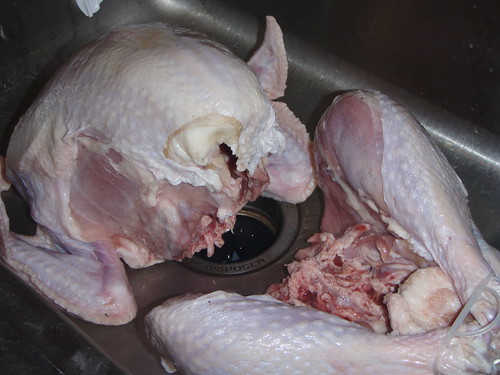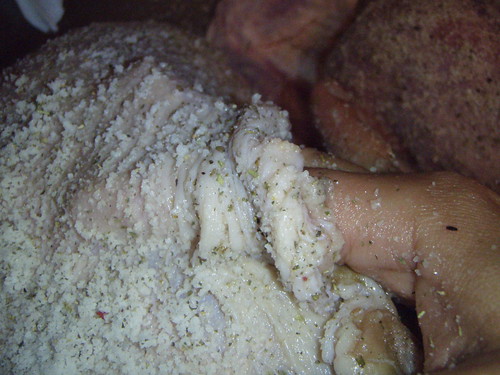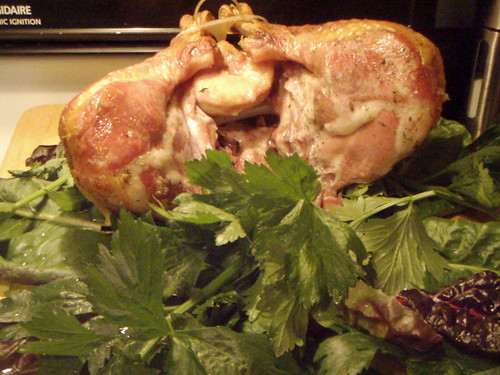Now, turkey and I have not always been on speaking terms. My Argentine mother, who could turn a chuck steak into something approaching filet mignon, was hopeless with the big bird. Not surprising, since she came from a culture that once used fowl in its spectator sports - and, yes, our Thanksgiving turkeys invariably had the interior texture of a soccer ball. I thought I didn't like turkey, and restricted myself to the dark meat smothered in as much gravy as I could muster.
One day I was at a friend's house for dinner; and her Midwestern-born-and-raised mother had roasted a turkey just for the heck of it. I'd never tasted anything like it: the breast meat was delicate and toothsome, not the slightly-turkey-flavored asbestos fibers I was used to. The dark meat was slipping gently off the bones, iron-y and delicious. None of it needed gravy, though gravy there was. My epiphany in poultry had to wait until I had my own kitchen and enough guests to help me eat a whole bird, but I never forgot that first non-dessicated bite and resolved to imitate it as soon as possible.
Of course, the issue with turkey is that the breast meat cooks at a different rate than the dark meat: you want to pull the breast at 155 or 160 degrees, but the dark meat is best if cooked to about ten or fifteen degrees higher. There are a million ways that people address this issue, but all of them have their drawbacks: butter doused-cheesecloth or aluminum foil heat shields on the breast leave you with soggy skin; brining requires a dedicated space and container, and spatchcocking or cutting up the bird takes away from that Norman Rockwell moment I really don't want to miss on Thanksgiving day.
Generally, my personal method was to cook the turkey to around 160, pull it, serve the perfectly-cooked breast, curse at the pink dark meat, put the dark meat back in the oven, forget it until it was dried out and later, smother it with sauce in some way (apparently David Rosengarten espouses this method, though he probably remembers to pull the dark meat in time) Of course, this method wasn't working for me, and I wished there was a way to separate the breast from the dark meat...but the more I thought about it, the more I thought I'd have a flat-chested turkey, and no girl wants that. I kept imagining inventing an aperture to replace the ribcage, so you could drape your breast meat over the thighs after they'd finished cooking.
Our grocery started offering very nice smallish every-day sort of turkeys, and as I love the bird, I'd purchase one now and again. A quarter-turkey is about exactly right for a meal for three people, so I'd quarter them, cook one portion, and freeze the remainder. My turkey epiphany had waited for this moment: I suddenly realized that the turkey's torso naturally separated the white and dark meat: the ribcage is attached to the thighs only by some skin and a thin strip of tissue. Even better, the spine of a turkey is unexpectedly easy to snap, just make the turkey do a pas de poisson and keep going until it breaks apart.
 Thus, when we got our 14-pound turkey for Thanksgiving last year, I treated it this way (note, if you're not squeamish about raw meat and meat juices, there's more pictures here.)
Thus, when we got our 14-pound turkey for Thanksgiving last year, I treated it this way (note, if you're not squeamish about raw meat and meat juices, there's more pictures here.) There's just a little tissue to cut after the spine is snapped; I left the legs trussed together and would recommend tying the drumsticks securely first, as this shape is going to be necessary later.
There's just a little tissue to cut after the spine is snapped; I left the legs trussed together and would recommend tying the drumsticks securely first, as this shape is going to be necessary later.  I cut the skin carefully so it was longer on the breast side, and I stretched the skin down over the gap and pinned it in place with skewers. I also cut off the big glob of fat that you find at the neck, cut it into two pieces, and stuffed a piece under the skin on each side of the breast.
I cut the skin carefully so it was longer on the breast side, and I stretched the skin down over the gap and pinned it in place with skewers. I also cut off the big glob of fat that you find at the neck, cut it into two pieces, and stuffed a piece under the skin on each side of the breast. After this, I dry-brined both sides, rubbing them well with well-seasoned sea salt until they were completely crusted over, and put them in the fridge, uncovered, until we were ready to cook (you can do it overnight, I did it in the morning and was happy with the result.)
After this, I dry-brined both sides, rubbing them well with well-seasoned sea salt until they were completely crusted over, and put them in the fridge, uncovered, until we were ready to cook (you can do it overnight, I did it in the morning and was happy with the result.) I made a little "rack" of leeks and onions, and set my dark meat in the roaster by itself in a 350 degree oven (I figured I wouldn't mess around with the raised and lowered temperatures, though in future I think the skin needs the higher temp to brown) rinsed off the dark meat, and cooked it for 30 minutes with its own thermometer set in the thigh (I just came up with the time randomly, since this was my first effort.)
I made a little "rack" of leeks and onions, and set my dark meat in the roaster by itself in a 350 degree oven (I figured I wouldn't mess around with the raised and lowered temperatures, though in future I think the skin needs the higher temp to brown) rinsed off the dark meat, and cooked it for 30 minutes with its own thermometer set in the thigh (I just came up with the time randomly, since this was my first effort.)When the time passed, I rinsed and dried the breast meat, stuffed the cavities with aromatics and herbs (onion, orange, rosemary and thyme) and plunked it down on top; it came together surprisingly easily.
Perhaps the most exciting thing I discovered was that the two separate parts of the turkey were very easy to remove; we thought the dark meat was done too early and were able to pull it without disturbing the breast; after checking it, we replaced it, no harm, no foul. So, when we decided the beast was done we pulled each part and reassembled them on the platter. After roasting, skewers were removed, skin stayed in place nicely. You would never know the turkey was in two parts:
* Back when I originally wrote this for LTHForum.com, when Sparky got 100% on his spelling tests, (as he did and does often) he would write "I'm a ginius" in response to the teacher's gold star. The world lost just a little bit of its charm when "genius" finally made it to the spelling list.







No comments:
Post a Comment